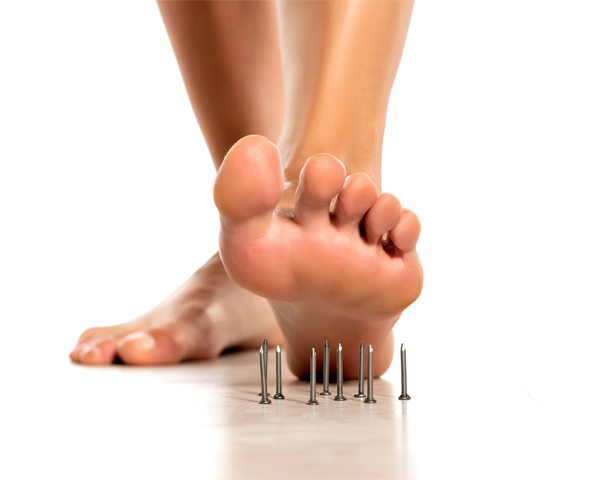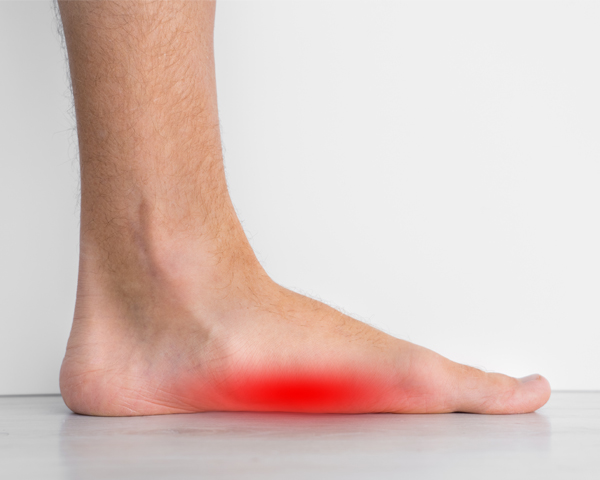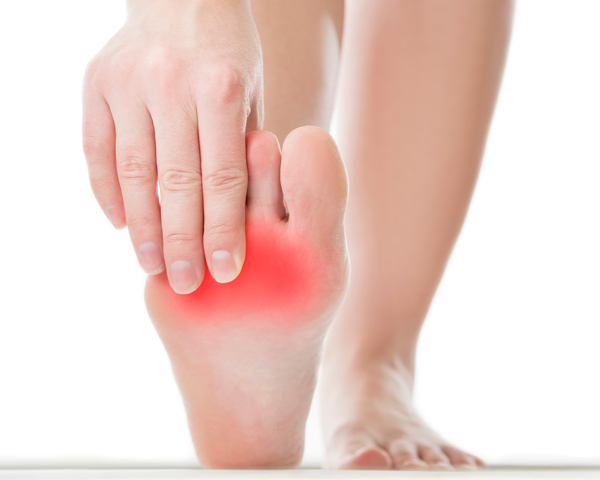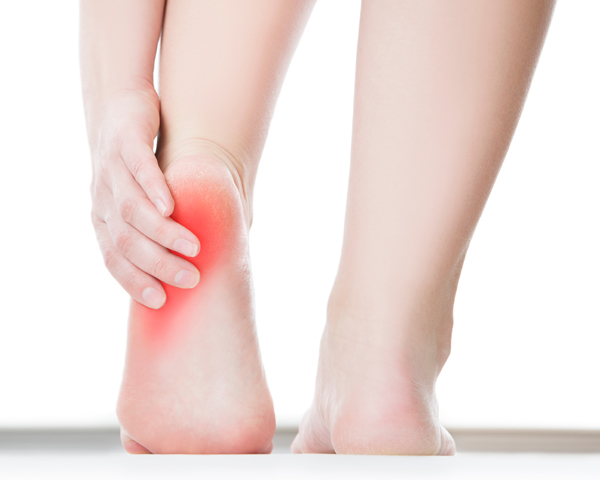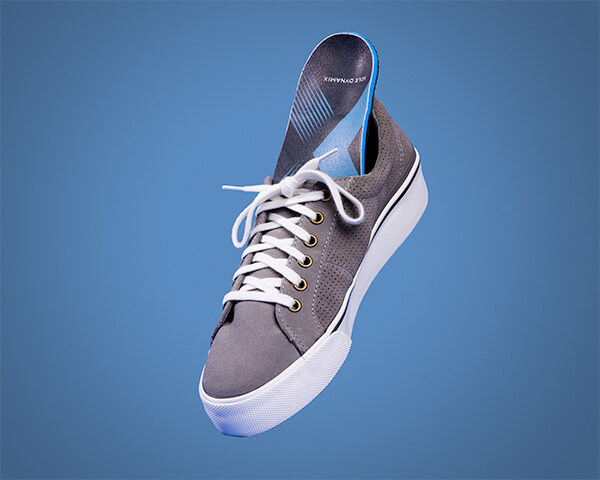Best Custom Insoles for 9 Foot Conditions

What Causes Your Foot Condition? How Can Custom Insoles Relieve It? Find Out! (This article is not medical advice.)
Ultimate Guide: Best Custom Insoles for 9 Foot Conditions
If you have a foot problem, you want a fast solution to relieve your pain. You also need to understand what the problem is, what causes it, and what you can do about it.
We have helped people like you for more than 20 years, so we’re going to explain nine of the main foot problems we see in patients today.
You can relieve these problems using custom insoles—ordered completely from home. We even build in special features to help with specific issues.
Not sure what your condition is called? Find out more by clicking on the area or function of the foot that is bothering you:
Once you see what foot condition fits your pain, you can use it to customize your insoles. Just click on your condition during your free 60-second foot assessment.
1. Plantar Fasciitis
You’re not alone! There are more than two million cases of plantar fasciitis per year in the US alone. It can really knock patients off their feet, keeping them from work and other activities.
Plantar fasciitis pain is often worse first thing in the morning or when you stand up after sitting for an extended time.
The plantar fascia is a sheet of tissues in the sole of the foot. Plantar fasciitis is caused by damage to these tissues, which results in inflammation, loss of mobility, and pain, especially in or near the heel.
What Causes Plantar Fasciitis?
Plantar fasciitis can be caused by:
- Poorly fitting shoes or hard work boots
- Walking on hard surfaces
- Standing or walking a lot for work or leisure
- The structure of your foot—such as flat feet or a high arch
You might also have a foot condition that causes your foot to roll inward while you walk (overpronation). This puts strain on ligaments and other tissues, causing inflammation, which can lead to plantar fasciitis.
Plantar Fasciitis Relief
Here’s what you want in your plantar fasciitis insoles:
- Padding: Shock-absorbing padding that covers the surface and gives you pain relief
- Semi-Flexible Arch Support: An arch with some flexibility—not too rigid—which stabilizes the front portion of the foot
- Heel Post: A sturdy, wide heel post or platform that keeps the foot stable, preventing too much rolling motion
- Open Heel (Optional): An open heel cutout filled with soft padding for added heel pain relief
With this combination of features in your custom shoe insoles, your feet could feel good again. You won’t have to worry about pain when you stand up any more.
2. Pes Planus (Flat Feet)
This is the most common foot problem on the planet. So don’t worry too much about what caused it or beat yourself up about it. It’s widespread, with 20–30% of people having it.
Pes planus means “flat feet.” A healthy foot should curve up in the inside middle of the foot to make an arch. But in pes planus, the arch is often lower or completely missing. This causes an inward rolling motion of the foot during each step as you walk.
This motion can cause ankle and foot deformities, knee and hip pain, back pain, and other issues, such as bunions and calluses.
What Causes Pes Planus?
For some patients, pes planus starts in childhood; sometimes, foot arches just don’t develop. Others get pes planus after an injury, and other cases are caused by aging, weight gain, or genetics.
Pes Planus Relief
The best shoe insoles for pes planus will include:
- Stabilizing Arch Support: A semi-flexible arch that prevents the foot from flattening out during walking while still allowing a natural range of motion
- Deep Heel Cup: A heel cup that wraps around the back of the foot to keep the heel in a healthy position, which helps to prevent flattening
- Square Heel Post: A platform for the heel that gives a wide base to prevent the foot from rolling inward
A custom pes planus insole, crafted specifically for you, will prevent your heel from rolling inward and prevent the foot from flattening when you step down. The rest of the foot follows the heel during each step, so controlling the heel helps align your whole foot.
Doctors commonly prescribe insoles for flat feet. Custom foot orthotics can give relief to your feet, ankles, knees, hips, and back.
3. Metatarsalgia
This condition causes pain and inflammation in the balls of the feet, the soft padding just behind the toes on the soles of the feet. It often focuses on the base of either the first or third toe.
Metatarsalgia sometimes causes tingling or numbness in the foot, aching, or a burning or shooting pain. You might feel like there’s a pebble in your shoe.
What Causes Metatarsalgia?
Often, there has been something putting pressure on the ball of the foot. This could include restrictive shoes, impact from sports or running, or weight gain. Also, past foot injuries are sometimes related.
Or you might have been born with narrow feet and high arches or flat feet. Other conditions can lead to metatarsalgia, including bunions, hammer toes, Morton’s neuroma, arthritis, and more.
Metatarsalgia Relief
The best insoles for metatarsalgia will give you:
- A Metatarsal Pad: Extra padding takes pressure off of the balls of the feet and transfers it to the rest of the foot
- Semi-Flexible Arch Support: Custom arch support in the insole’s shell helps take stress off of the balls of the feet
We designed this insole modification based on years of experience with patients like you. It takes stress and strain off of the sensitive area right behind your toes and puts pressure more naturally on the rest of the foot.
You may want to wear more comfortable shoes and take a look at activities that put strain on your feet. But custom shoe insoles can make your feet a whole lot more comfortable in your everyday activities.
4. Morton’s Neuroma
“It feels like there’s a pebble in my shoe!” That’s a common phrase for people who have Morton’s neuroma. Also, “It feels like my sock is bunched up under my foot.”
This condition can cause a sharp, burning pain in the ball of the foot and/or a burning, stinging, or numbness in the nearby toes. These sensations usually start small and gradually get worse.
What Causes Morton’s Neuroma?
A build up of tissue that has thickened around a nerve in the foot leading to the toes, putting pressure on the nerve. This can happen because of:
- An injury
- Repetitive pressure from a sport
- Other foot conditions, such as hammertoes or flat feet
- High heels
Morton’s Neuroma Relief
If you’re shopping for shoe insoles for Morton’s neuroma, they should include:
- Metatarsal Pad: This soft pad under the ball of the foot channels pressure away from the sensitive area.
- Arch Support: Sole Dynamix arches are made from semi-flexible material that absorbs part of your weight while standing, relieving pressure.
- Shock Absorption Layer: The shock-absorbing insole padding reduces the shock of each step, giving relief to the balls of the feet.
Morton’s neuroma is sometimes linked to tight or high-heeled shoes. You could try roomier shoes with lower heels and soft soles. Other people have gotten injections to relieve inflammation or surgery to repair the nerve, but ordering condition-specific insoles can improve your results with any other methods.
5. Heel Spurs
Each heel spur is a calcium buildup in a heel bone. If it presses on nearby tissue, it causes damage, pain, and swelling.
It’s hard to relieve heel spur inflammation unless you get intervention from a medical treatment and/or the best insoles you can find.
What Causes Heel Spurs?
It depends. It could be related to any of the following (or a combination):
- Plantar fasciitis, which causes strain and inflammation, leading the body to create extra bone material because of the stress
- Injuries from running or jumping, especially on hard surfaces
- Damage to your feet from working all day standing up
- A problem with your gait, or walking style
- Flat feet
- Arthritis
- Aging
Heel Spur Relief
A great custom insole supports and relieves the soles of your feet and your heels, along with correcting gait issues. Insoles provide:
- An Open Heel: A cutout area under the heel filled with extra padding, which relieves pressure on the heel spurs
- Extra Arch Support: A semi-flexible arch that spreads pressure throughout the whole foot, taking weight off of the heel
- Relief for a Related Issue: If your heel spurs are caused by a another issue, such as overpronation or plantar fasciitis, your insoles can have added features that focus on relieving the other issue
The features above, along with a full layer of padding and a customized shell, take weight off of your heels, transferring pressure to other parts of your feet. This keeps your feet comfortable and helps to support the healing process.
6. Hammer Toes
A hammer toe is your second, third, or fourth toe getting bent upward at the middle joint. As this gets worse, the joint can get stuck in an uncomfortable position.
What Causes Hammer Toes?
Hammer toes can be caused by pressure on the toe’s tendons and joints. If a toe is bent for too long of a time—say, by short, narrow, or high-heeled shoes—the toe muscles can lose their ability to straighten the toe.
Hammer Toe Relief
Great custom insoles can relieve the pain of hammer toes with these features:
- Metatarsal Pad: This insole pad helps to gently stretch the long ligaments of the toes, allowing them to relax.
- Padding: The hammer toe condition can force the tip of the toe downward, causing pain when you’re standing. A layer of high-quality padding gives a soft, pain-relieving place for toes to rest.
Look carefully at your favorite shoes. They should fit well, leave plenty of room for your toes, and be adjustable with laces or straps to give your feet and toes more room.
We also recommend trying lower heels and shoes that fit great immediately when you buy them. Plus, great shoes can be enhanced by clinically designed condition-specific insoles.
7. Bunions
A bunion is a bump on the side of the foot near the base of your big toe. You might have redness or other discoloration, swelling, pain or stiffness in the big toes, and problems wearing certain shoes.
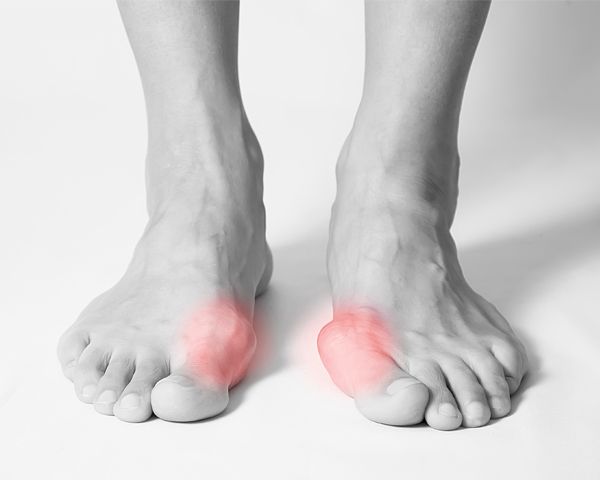
What Causes Bunions?
Bunions form when the big toe is bent too far towards the other toes, pushing the big toe’s first joint out. This causes trauma in the tissue around the joint.
Tight, narrow shoes can cause bunions or make them worse, but some bunions are hereditary or related to a separate medical condition, like arthritis. In general, many bunions are caused by forces pushing the big toe toward the other toes.
Bunion Relief
Bunions can’t clear up on their own. High-quality shoe insoles for bunions will include:
- Arch Support: Some bunions are caused by overpronation, or your foot rolling too far inwards. So, your shoe insole’s arch should prevent your foot from flattening and rolling inward too far. This can then relieve pressure on the bunion.
- Medial Wedge: Bunions can be caused by too much pressure falling on the inner edge of the foot as you walk. A custom insole should be thickened under that inner edge, helping move pressure away from the big toe—and stopping the bunion’s growth.
Wearing shoes that fit better can also stop a bunion from getting worse. When you’re buying shoes, you can try a few different sizes (beyond your normal size) to see if a different size is more comfortable.
Your medical professional might suggest surgery to correct your bunions. But remember, if your shoes and/or foot movements have caused your bunions, you may need better shoes and custom insoles to help stop a bunion from forming again.
8. Pronation
Your foot is supposed to bend at the arch when you step down. The foot should even roll a little bit toward the midline.
But overpronation means the foot rolls inward too far, causing extra stress on the foot, which can lead to injuries, including ankle strain, as well problems in the knees, hips, or lower back.
When the arch collapses during walking or running, the natural shock absorption it provides is hampered.
Overpronation is similar to flat feet. But with typical flat feet, the foot is flat all the time, even when you’re sitting down. But in overpronation, the foot flattens during each step when you’re walking or running.
What Causes Overpronation?
Overpronation often develops over time. Someone’s arches may flatten out from:
- Walking or running on hard surfaces
- Pregnancy
- Obesity
- Aging
- Genetics
Or you might have started with somewhat flat feet from genetics. Then, outside conditions may have pushed this into overpronation.
Overpronation Relief
Customized insoles are one of the best ways to relieve pain caused by overpronation. A great custom foot orthotic will feature:
- Semi-Flexible Arch Support: An arch that is just flexible enough to prevent foot flattening but still allow a natural range of motion—created by controlling the width of the insole material during 3D printing
- Broad Heel Post: A wide surface under the heel that prevents the heel from rolling during each step, supporting natural movements throughout the foot
During overpronation, too much weight falls on the inside edge of the foot, which can lead to injuries. So the best insoles reduce that risk and relieve pain all through the lower extremities—the ankles, knees, hips, and lower back.
9. Supination
In supination, the foot rolls outward too far on each step. That means the outer edge of the foot is taking a lot more weight than it should.
This motion also strains and stresses the muscles, tendons, and ligaments that support the feet and ankles, which may cause pain, along with higher risk of injury.
When feet roll outward, they can’t adapt to the ground or floor. And the related bones and muscles have to work harder for balance and posture control, leading to tension, which may cause problems in your calves, knees, hips, and back.
What Causes Supination?
Feet often reach this condition gradually. Some patients have been wearing a type of shoe that causes an outward rolling motion—shoes that are too tight or rigid.
Or you might have suffered an injury that damaged your muscles or tendons, which are pulling your feet into a new position. Or some aspect of the rest of your body may be out of alignment.
Supination Relief
Supination insoles give you several features to help your feet as you recover and adapt to a more comfortable way of walking:
- Supination Wedges: An added heel wedge—a tilted part of the insole—gently nudges the heel back toward the midline of the foot, preventing the foot from rolling outward
- Semi-Flexible Arch Support: As your foot comes back to a more neutral position, our semi-rigid material supports your foot arch while allowing natural movement.
- Strain-Reducing Padding: A layer of superior padding covers the entire insole, absorbing 90% of the shock of each step
By controlling the movement of the heel, a custom insole controls the rest of the foot. This can help you avoid rolling your ankles. It may also make your feet more comfortable immediately, as well as healthier in the long-term.
Foot Pain Relief
Custom insoles can help with the real causes of foot problems for some patients. Sure, you could take a pill or get an injection to relieve the pain, but a quality custom shoe insole moves your feet through healthier positions—while reducing pressure on sensitive areas, such as your soles, heels, and toes.
If you have one or more of the foot conditions above, select it when you go through the Sole Dynamix questionnaire here. We’ll show you the best insoles, which we will customize based on your needs.
Our website currently handles the conditions below (and combinations of them):
- Plantar fasciitis
- Flat feet
- Metatarsalgia
- Pain in the balls of the feet
- Morton's neuroma
- Heel spurs
- General heel pain
- Hammer toes
- Bunions
- Pronation
- Supination
Take care of your feet! Get pain relief and comfort. Over the decades, we’ve refined a wide range of techniques, including 3D scanning and 3D printing, to make custom insoles that help get rid of pain, improve the way people walk, and promote better foot health. Get your custom insole recommendation with our free 60-second assessment:
Editor's note: This post was originally published in August 2023 and has been updated with three additional foot conditions, along with navigation features.

